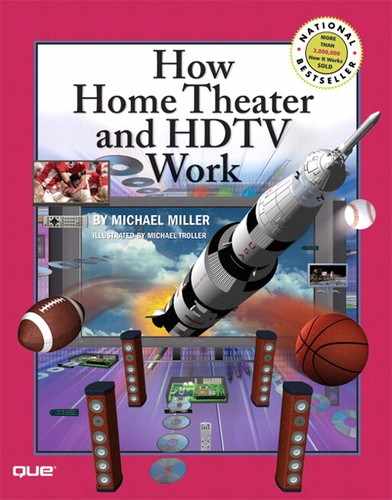To many consumers, the phrase home theater system really means widescreen television. While a big TV (with HDTV capability) is certainly the visual centerpiece of a home theater, the full theater experience depends as much on sound as it does on picture. To that end, it’s important to pay as much attention to the audio components in your system as to the video display.
Home audio systems have been around a lot longer than home video systems. The original home audio system was a simple single-speaker AM radio; today’s home audio systems are more likely to include multiple audio sources and multiple speakers. (And, yes, most systems today can still receive those primitive low-fidelity AM signals.)
Audio is important not just for listening to music, but also for watching big-screen movies. Virtually all movies made over the past decade or so utilize surround sound, which places the soundtrack all around the listener. Dialogue comes from the front of the room, special effects come from behind, and music fills the entire listening space. This is especially noticeable in special-action/adventure films; Lord of the Rings is a lot more impressive on a good surround-sound system than it is on a single-speaker television set.
To fill your home theater room with sound, you need the right equipment—and the right technology. It all starts with a component called an audio/video receiver, which functions as the control center of your entire system. Most A/V receivers let you connect all your audio and video components and then switch between inputs with a single remote control. You connect your CD player, DVD player, digital video recorder, and cable/satellite box to the inputs of your A/V receiver and then connect the output of the A/V receiver to your video display. Whatever you select on the receiver’s remote appears on the television screen.
The A/V receiver also serves as the main processor/amplifier for your system’s audio. Surround-sound sources (either broadcast or DVD) are fed into the receiver, which decodes the surround-sound signal using the appropriate technology. Most soundtracks today are encoded with Dolby Digital surround sound, which feeds the audio to six separate speakers—three in the front of the room, two in the back, and a final subwoofer for the deep bass signals. Pop in a DVD with a Dolby Digital soundtrack, and your A/V receiver will create room-filling sound.
Of course, the sound you hear is strongly affected by the speakers you use. Some consumers prefer small, unobtrusive bookshelf speakers that can be easily placed in any living room. Others prefer larger floor-standing speakers that are better for reproducing music. (Remember, your home theater system will also function as your main music system, so music CDs are every bit as important as movie soundtracks.) Whichever type of speaker system you choose, the main sound will be supplemented by a separate subwoofer, which reproduces the very lowest bass frequencies; you need a good sub to hear all the rumbles and explosions in action/adventure films.
When you’re budgeting for a new home theater system, you should actually spend more money on the audio components than you do on the video display. Figure spending a third of your budget on the television set, a third on speakers, and a third on the A/V receiver and other source components (such as a DVD player). As with all electronic devices, the bigger your budget, the better the components you can get—in terms of both functionality and sound quality.
Shopping for audio components requires careful listening. You should always test drive receivers and (especially) speakers before you buy; specifications alone aren’t a good barometer of how a system will actually sound. A higher-powered receiver might not sound as good as a lower-powered one, nor do bigger speakers always sound better than smaller ones. Specs are important, but they don’t tell the whole story.
And here’s something that might surprise you: As impressive as a slam-bang surround sound movie soundtrack might sound, movie audio is actually much less demanding for a system than music audio. That’s because, despite the deep bass and loud explosions, the dynamic range of a movie soundtrack is less than that of a good music CD. Your favorite DVD might be loud, but it really isn’t that impressive from a pure audio standpoint.
Reproducing music—especially acoustic music—is much more demanding. A high-quality music CD has a very wide dynamic range, meaning that the soft passages are very soft and the loud passages are very loud. In addition, music uses a full range of frequencies (from the lowest bass notes to the highest highs of a cymbal), whereas movie sound effects are typically limited to a small frequency range. The proof is in the listening; most DVD soundtracks sound good on even moderately priced audio systems, but music CDs require high-fidelity audio systems to achieve their full sonic potential.
Don’t rely on the source material in the showroom, either; take your own DVDs and CDs to try the components you’re interested in. (It’s important to use material that you’re familiar with, so you’ll know how it should sound.)And when in doubt, go by weight; for some reason, the best audio components are almost always the heaviest!

